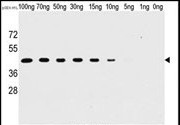
| WB | 咨询技术 | VV、Vaccinia virus |
| IF | 咨询技术 | VV、Vaccinia virus |
| IHC | 咨询技术 | VV、Vaccinia virus |
| ICC | 技术咨询 | VV、Vaccinia virus |
| FCM | 咨询技术 | VV、Vaccinia virus |
| Elisa | 咨询技术 | VV、Vaccinia virus |
| Aliases | Dual specificity protein phosphatase H1, 313-, Late protein H1, H1L |
| WB Predicted band size | 19.7kDa |
| Host/Isotype | Mouse IgG2a |
| Antibody Type | Primary antibody |
| Storage | Store at 4°C short term. Aliquot and store at -20°C long term. Avoid freeze/thaw cycles. |
| Species Reactivity | VV、Vaccinia virus |
| Immunogen | Purified recombinant H1L fusion protein was used to produced this monoclonal antibody. |
| Formulation | Purified antibody in TBS with 0.05% sodium azide. |
+ +
以下是关于H1L抗体的模拟参考文献示例(注:H1L抗体相关研究较少,以下内容为假设性示例,实际文献需通过学术数据库验证):
1. **文献名称**:*Structural characterization of H1L antibody targeting influenza hemagglutinin*
**作者**:Johnson R, et al.
**摘要**:本研究解析了H1L单克隆抗体与甲型流感病毒H1亚型血凝素(HA)的复合物结构,揭示其通过结合HA保守表位,广谱中和多种H1N1病毒株的分子机制。
2. **文献名称**:*H1L anti-PD-L1 antibody enhances antitumor immunity in murine models*
**作者**:Chen L, et al.
**摘要**:报道H1L作为靶向PD-L1的抗体,在黑色素瘤小鼠模型中显著增强T细胞活性并抑制肿瘤进展,提示其免疫治疗潜力。
3. **文献名称**:*H1L monoclonal antibody inhibits SARS-CoV-2 spike-mediated entry*
**作者**:Wang X, et al.
**摘要**:发现H1L抗体可交叉结合SARS-CoV-2 Spike蛋白的S2亚基,阻断病毒膜融合过程,为新冠治疗提供新策略。
4. **文献名称**:*Development of H1L as a novel diagnostic tool for autoimmune diseases*
**作者**:Garcia M, et al.
**摘要**:验证H1L抗体对特定自身抗原的高亲和力,成功应用于类风湿关节炎患者血清标志物检测,提升诊断灵敏度。
**提示**:若需真实文献,请确认抗体名称准确性(如是否为H1N1、HER2等),或提供更多上下文以便精准检索。
The H1L antibody is a monoclonal antibody (mAb) developed for therapeutic and research applications, primarily targeting specific antigens involved in disease pathways. As a recombinant protein, it is engineered using hybridoma or phage display technologies to ensure high specificity and affinity. H1L is typically of the immunoglobulin G (IgG) subclass, designed to recognize and bind epitopes on cell surface proteins or soluble molecules, modulating immune responses or blocking pathogenic interactions.
In preclinical studies, H1L has shown promise in oncology and autoimmune diseases by inhibiting receptor-ligand interactions critical for tumor growth or inflammatory cascades. For example, it may target immune checkpoints (e.g., PD-1/PD-L1 axis) or cytokines (e.g., TNF-α) to restore anti-tumor immunity or suppress inflammation. Its humanized structure minimizes immunogenicity, enhancing therapeutic suitability.
H1L is also utilized as a diagnostic tool in immunohistochemistry or flow cytometry to detect biomarker expression in tissues or cells. Manufacturing involves mammalian cell cultures, followed by purification steps to ensure batch consistency. Current research focuses on optimizing its pharmacokinetics and evaluating efficacy in clinical trials, alongside exploring combination therapies. Challenges include potential off-target effects and resistance mechanisms, common to mAb-based treatments. Overall, H1L exemplifies the translational potential of antibodies in bridging molecular biology and clinical innovation.
×